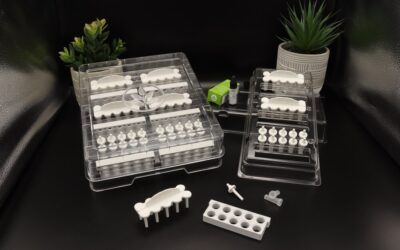
Allergies affect millions of people worldwide, ranging from seasonal sniffles to life-threatening reactions. While avoidance is often the first line of defense, many individuals require additional treatments to manage symptoms effectively. In this blog, we’ll explore allergy treatments, from over-the-counter remedies to advanced immunotherapy options.
WARNING Important Safety Information (See full prescribing information for complete boxed warning.)
Intended for use only by licensed health care provider experienced in administering allergenic extracts and trained to provide immediate emergency treatment in the event of a life-threatening reaction. Observe patients for at least 30 minutes following administration. Immunotherapy may not be suitable for patients with medical conditions that reduce their ability to withstand a systemic reaction. Allergenic extracts can cause serious systemic reactions; including anaphylactic shock and in rare cases death, especially in patients who have severe or steroid-dependent asthma, cardiovascular disease, or in patients who use beta blockers. Do not inject intravenously. Additionally, the reconstituted single venom products are intended for subcutaneous injection for immunotherapy and percutaneous use for diagnosis. The Mixed Vespid venom protein is for immunotherapy only, not for diagnosis. Diagnosis should be based on individual venoms. Refer to contraindications, warnings, precautions, adverse reaction and over dosage for more detailed information.
Understanding Allergies
Brief Overview of Allergies and Common Allergens:
According to Allergies: Overview found on the National Library of Medicine, allergies occur when the body’s immune system overreacts to foreign substances, such as pollen or food. Allergies are usually harmless in most people but can cause dangerous or severe reactions in others. These allergic reactions typically cause issues on the skin, in the mucous membranes, and in a person’s airways. These symptoms occur right after a person encounters an allergen, but it can take a few hours to several days for a reaction to appear. However, it’s important to conduct allergy testing when a potential allergy exists, as hypersensitivity to a substance can sometimes be mistaken for an allergy.1
Some of the most common allergens include1:
- Pollen
- Dust mites
- Pets/farm animals
- Venom in insect stings and bites
- Foods
- Medication
- Contact allergens (like metals and/or fragrance ingredients)
- Mold
Brief Explanation of Allergic Reactions and Symptoms:
Most allergic reactions typically occur in the same area of the body that they come in direct contact with.1
Common allergy symptoms include:
- A runny nose, coughing, and/or sneezing
- Breathing problems
- Watery eyes
- Itching
- Rash
- Swollen mucous membranes
While most allergy symptoms aren’t serious, there is a chance for a potential severe allergic reaction called anaphylaxis. Anaphylaxis is a medical emergency and a life-threatening acute reaction to an allergen. This reaction is defined as a rapidly evolving, generalized, multi-system allergic reaction that, without treatment, can be fatal because of its rapid progression that leads to respiratory collapse.7
Over-the-Counter Allergy Treatment Options
Antihistamines for Allergies:
According to “The Role and Choice Criteria of Antihistamines in Allergy Management”, allergies have grown to epidemic status with over 600 million people suffering from allergic rhinitis worldwide. Because of this, there’s been an increased need for allergy treatments and aids to reduce or minimize allergy symptoms. The first step treatment for most people is over-the-counter antihistamines, like Benadryl or Cetirizine (Zyrtec).
Quick Review of Histamines in the Allergy Response:
When seeing the word “antihistamines”, there is the question on what role histamines play in the allergic response. Histamine influences the immunoregulation of the acute and chronic inflammatory response through four types of receptors, the H1, H2, H3, and H4 receptor6. The H1 receptor plays an important role when it comes to histamine dependent allergies. When the H1 receptor is stimulated by histamine, the smooth muscles in the respiratory tract constrict, there is an increased permeability of endothelium (the inner cellular lining of the blood vessels), and the sensory nerves and cough receptors are stimulated, resulting in sneezing, runny nose, and itching.6
Two Generations of Antihistamines:
Originally, there was a first generation of antihistamines (sometimes referenced as classical antihistamines) that acted non-selectively on the various histamine receptors. These first-generation antihistamines had adverse reactions because they also blocked muscarinic receptors, adrenoreceptors, and dopaminergic receptors. High lipophilicity and easy crossing of the blood-brain barrier also intensified adverse effects to the central nervous system including drowsiness and decreased concentration among others.6
Second generation antihistamines, like the before mentioned Benadryl and Certirizine, are one of the greatest breakthroughs in the history of antihistamines due to the fact that they selectively act on the H1 receptors. This drastically reduced the number of adverse reactions that came with using antihistamines to treat an allergic reaction. Because second generation antihistamines only react with H1 receptors, they’re highly effective in the reduction of allergic rhinitis and urticarial (hives) and can be used in relatively high doses without concerns of overdose. This is drastically different from first generation antihistamines, which, when taken at high doses, could cause consciousness disturbances, coma, respiratory distress, and even death.6
In the overall discussion of antihistamines, it’s important to note that over-the-counter antihistamines should not be used as a defense or first line treatment for anaphylaxis.
Decongestants for Allergies:
Decongestants offer a quick solution to the discomfort of a blocked or stuffy nose, commonly experienced during colds, flu, allergies, and sinus issues. These medications, which are available in various forms such as nasal sprays, tablets, liquids, and flavored powders, work by reducing the swelling of blood vessels in the nasal passages which then allows easier breathing.9
However, while they provide temporary relief, it’s crucial to be aware of potential side effects. As the NHS warns, decongestants may have adverse effects when used for an extended period or in excessive amounts. Some products even combine decongestants with other medications like painkillers or antihistamines, which can further complicate prescriptions. Because of this, it’s important to consult a healthcare professional before long-time use or deciding decongestants are the best treatment option for each patient.
Nasal Sprays for Allergies:
There are various types of nasal sprays that can be used in the treatment of allergies, including:
- Fluticasone propionate
- Beclomethasone dipropionate
- Mometasone furoate
- High-dose steroids
- Low-dose steroids
- Aqueous nasal spray
- Aerosol spray
The goal of topical/intranasal corticosteroid nasal sprays is to reduce inflammation in the sinonasal mucosa to improve allergy symptoms. They are usually prescribed to patients who experience chronic rhinosinusitis with specific treatment plans based on the variety of options.3 For allergic rhinitis that affects quality of life, intranasal corticosteroids are the best initial treatment as it is demonstrated to be more effective than oral and intranasal antihistamines in the treatment of persistent allergic rhinitis.11
Prescription Options for Allergy Treatment
Leukotriene Modifiers for Allergies:
According to “The Emerging Role of Leukotriene Modifiers in Allergic Rhinitis”, the efficacy of leukotriene modifiers in managing asthma has led to speculation about their potential application in treating allergic rhinitis. Researchers have been intrigued by the possibility of these medications offering relief for nasal symptoms associated with allergies. While studies have demonstrated improvements in nasal symptoms compared to placebos when using leukotriene modifiers, the debate persists regarding their superiority over traditional antihistamines.5
Despite promising results, conclusive evidence is still lacking in establishing leukotriene modifiers as a more effective option for managing allergic rhinitis. This treatment option requires further research to better understand the role of these medications in nasal allergy treatment.
Mast Cell Stabilizers for Allergies:
Mast cells are “central players” to the development and maintenance of allergies and are used to treat asthma, allergic rhinitis, and allergic conjunctivitis. Mast cell stabilizing drugs inhibit the release of allergic mediators from mast cells to prevent allergic reactions. There a many different natural and synthetic mast cell stabilizers available for treatment, and the patient is prescribed the correct one for their symptoms after meeting with a medical professional.4
Immunotherapy Options for Allergy Treatment
Sublingual Immunotherapy (SLIT) for Allergies:
According to “Sublingual Immunotherapy for Food Allergy and Its Future Directions”, sublingual immunotherapy, or SLIT, is a newer option for food allergy treatment that involves placing the glycerinated allergen under the tongue daily to achieve specific desensitization to that allergen. SLIT has been studied in the treatment of peach, apple, hazelnut, milk and peanut allergies, with a specific focus on peanut allergies. These therapies require daily dosing to maintain tolerance and haven’t appeared to achieve long-term tolerance.10
Subcutaneous Allergy Immunotherapy for Allergies:
Subcutaneous allergy immunotherapy (AIT), or allergy shots, is an allergy treatment that results in desensitization through regular injections. AIT was first introduced in 1911 by Leonard Noon and John Freeman when they injected increasing doses of timothy pollen in distilled water in patients to alleviate symptoms.8
According to Memon, Ruba J., et al, AIT is a vital treatment modality for various allergic conditions, particularly when symptoms are moderate to severe, and evidence points to an IgE-mediated reaction. This treatment option finds application across a spectrum of allergic ailments, including:
- Allergic rhinitis
- Asthma
- Conjunctivitis
- Rhino-conjunctivitis
- Atopic dermatitis
- Immune-mediated food allergies
Identifying IgE-mediated reactions through blood tests or skin testing is crucial before initiating AIT to ensure that the treatment is tailored to the patient’s specific allergic profile. AIT is typically comprised of allergenic proteins sourced from pollen, dander, dust mites, insects, molds, stinging insect venom, and other allergens.8
These proteins are combined with diluents, solvents, and preservatives to result in the final product. Various extract types, such as aqueous, glycerinated, lyophilized, acetone precipitated, and alum-precipitated, offer flexibility in accommodating the needs and sensitivities of a diverse patient group.8 However, since AIT is injected directly, there is always a possibility of an adverse reaction, so this treatment option can only be prescribed and provided by a medical provider.
At HollisterStier Allergy, we provide an assortment of allergy extracts for allergists to use for AIT and VIT (venom immunotherapy). Some of our available extracts include:
- Dog hair extracts
- Cat hair and pelt extracts
- Mite extracts
- Venom extracts
- Insect extracts
- Pollen extracts
- Mold extracts
- Horse and cattle extracts
- Food extracts
Your patients living with allergies may be facing constant discomfort or face limitations due to their allergy. By understanding the range of available treatments, these individuals can work with healthcare providers to develop personalized plans for managing their symptoms effectively. Finding the right combination of treatments may require some trial and error, but with patience and persistence, relief is possible.
Contact us today to learn more about our available allergy extracts
Article References
1“Allergies: Overview.” Nih.gov, Institute for Quality and Efficiency in Health Care (IQWiG), 13 July 2017, www.ncbi.nlm.nih.gov/books/NBK447112/.
2Almutairi, Talal A, et al. “Safety Concerns of Nasal Corticosteroids Usage in Patients with Allergic Rhinitis.” Cureus, 23 Nov. 2020, www.ncbi.nlm.nih.gov/pmc/articles/PMC7686935/, https://doi.org/10.7759/cureus.11651.
3Chong, Lee Yee, et al. “Different Types of Intranasal Steroids for Chronic Rhinosinusitis.” Cochrane Database of Systematic Reviews, vol. 2016, no. 4, 26 Apr. 2016, https://doi.org/10.1002/14651858.cd011993.pub2.
4Finn, D F, and J J Walsh. “Twenty-First Century Mast Cell Stabilizers.” British Journal of Pharmacology, vol. 170, no. 1, 15 Aug. 2013, pp. 23–37, https://doi.org/10.1111/bph.12138.
5Grayson, Mitchell H., and Phillip E. Korenblat. “The Emerging Role of Leukotriene Modifiers in Allergic Rhinitis.” American Journal of Respiratory Medicine: Drugs, Devices, and Other Interventions, vol. 2, no. 6, 2003, pp. 441–450, pubmed.ncbi.nlm.nih.gov/14719983/, https://doi.org/10.1007/BF03256671. Accessed 11 Apr. 2024.
6Kuna, Piotr, et al. “The Role and Choice Criteria of Antihistamines in Allergy Management – Expert Opinion.” Advances in Dermatology and Allergology, vol. 6, 2016, pp. 397–410, www.ncbi.nlm.nih.gov/pmc/articles/PMC5183790/, https://doi.org/10.5114/pdia.2016.63942.
7McLendon, Kevin, and Britni T Sternard. “Anaphylaxis.” National Library of Medicine, StatPearls Publishing, 26 Jan. 2023, www.ncbi.nlm.nih.gov/books/NBK482124/.
8Memon, Ruba J., et al. “Allergy Desensitization.” PubMed, StatPearls Publishing, 2020, www.ncbi.nlm.nih.gov/books/NBK535367/.
9NHS. “Decongestants.” Nhs.uk, 18 Oct. 2017, www.nhs.uk/conditions/decongestants/.
10Schworer, Stephen A, and Edwin H Kim. “Sublingual Immunotherapy for Food Allergy and Its Future Directions.” Immunotherapy, vol. 12, no. 12, Aug. 2020, pp. 921–931, https://doi.org/10.2217/imt-2020-0123.
11Sur, Denise K. C., and Monica L. Plesa. “Treatment of Allergic Rhinitis.” American Family Physician, vol. 92, no. 11, 1 Dec. 2015, pp. 985–992, www.aafp.org/pubs/afp/issues/2015/1201/p985.html.



